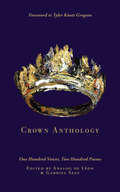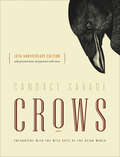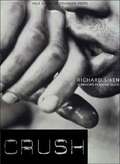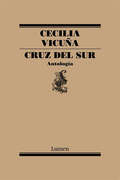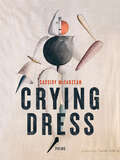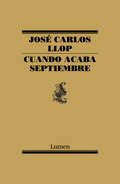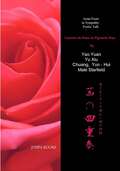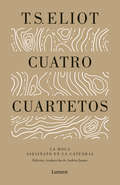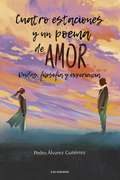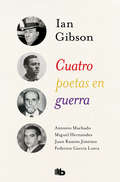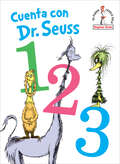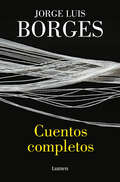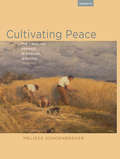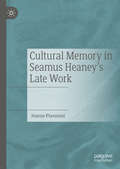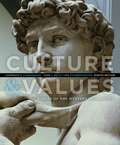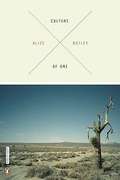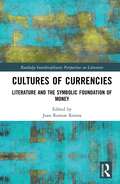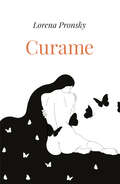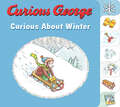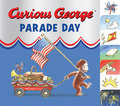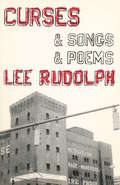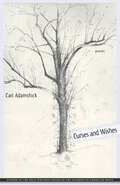- Table View
- List View
Crow-Work: Poems
by Eric PankeyFrom the award-winning author of Augury, a poetry collection that examines the power of great works of art.“What is a song but a snare to capture the moment?” This central question drives Crow-Work, Eric Pankey’s ekphrastic exploration of the moment where emotion and energy flood a work of art.Through subjects as diverse as Bruegel’s Procession to Calvary, Anish Kapoor’s Healing of Saint Thomas, Caravaggio’s series of severed heads, and James Turrell’s experimentation with light and color, the author travels to an impossible past, despite being firmly rooted in the present, to seek out “the songbird in every thorn thicket” of the artist’s work. Short bursts of lyrical beauty burn away “like coils of incense ash”; bodies in the light of a cave flicker, coalesce, and disappear. By capturing the ephemeral beauty of life in these poems, Crow-Work seeks not only to explain great art, but also to embody it.Praise for Crow-Work“Eric Pankey’s sensibility is an unerringly generous one: he is always willing to step first onto unsteady ground, to test it for those who might follow. The poems of Crow-Work, like good gleaners, seek out possibility and sustenance. They are skilled, deft, and dazzlingly alert. Just when I think they have brought me as close as possible to the dark and unknowable things that make awe possible, they bring me closer. The journey is unnerving, intimate, and thrilling.” —Mary Szybist“The delicacy and accuracy we have come to expect from Eric Pankey are here on display and as deftly deployed as ever. Pankey remains one of our leading practitioners of the metaphysical poem.” —C. Dale Young“[A] wonderful exploration of the emotional power of art.” —Publishers Weekly (Starred Review, PW Picks)
Crown Anthology: One Hundred Voices, Two Hundred Poems (Lost Poets)
by Analog de Leon & Gabriel SageTwo hundred poems of hope and empowerment in a time of tumult and darkness, from Instagram’s Lost Poets community. Crown Anthology is a new collection of verse from an online subculture of poets, with a foreword by Tyler Knott Gregson, one of the movement’s foremost authors. By celebrating self-love, self-worth, and empowerment, these two hundred poems examine life in a dynamic and transformative poetry compilation that speaks soft words reminding us that every soul is royal. Featuring a beautifully diverse and inspirational set of voices from around the world, which includes some of today’s most influential modern poets with additional contest winners chosen from 4,500 submissions, Crown Anthology is curated to be a light in the wild dark, illuminating the crown that exists in everyone.
Crown Anthology: One Hundred Voices, Two Hundred Poems (Lost Poets)
by Analog de Leon & Gabriel SageTwo hundred poems of hope and empowerment in a time of tumult and darkness, from Instagram’s Lost Poets community. Crown Anthology is a new collection of verse from an online subculture of poets, with a foreword by Tyler Knott Gregson, one of the movement’s foremost authors. By celebrating self-love, self-worth, and empowerment, these two hundred poems examine life in a dynamic and transformative poetry compilation that speaks soft words reminding us that every soul is royal. Featuring a beautifully diverse and inspirational set of voices from around the world, which includes some of today’s most influential modern poets with additional contest winners chosen from 4,500 submissions, Crown Anthology is curated to be a light in the wild dark, illuminating the crown that exists in everyone.
Crows: Encounters with the Wise Guys of the Avian World
by Candace SavageA treasure trove of stories, poems, and information on the brainy, black-feathered bird that&’s rich in insight and humor. This revised and expanded edition of Candace Savage&’s best-selling book about ravens and crows is enhanced by additional paintings, drawings, and photos, as well as a fascinating selection of first-person stories and poems about remarkable encounters with crows. In one story, a pack of crows brilliantly thwarts an attack by a Golden Eagle; in another, a mischievous crow rescues the author from grief. And in a third piece, after nursing a battered baby crow back to health until it flies off with other crows, Louise Erdrich hauntingly describes her altered awareness as she listens for the &“dark laugh&” of crows while she works. Based on two decades of audacious research by scientists around the world, the book also provides an unprecedented, evidence-based glimpse into corvids&’ intellectual, social, and emotional lives. But whether viewed through the lens of science, myth, or everyday experience, the result is always the same. These birds are so smart—and so mysterious—they take your breath away.Published in Partnership with the David Suzuki Institute.Praise for Crows &“A beautifully crafted celebration of these birds.&” —Nature &“A deft juxtaposition of interesting anecdotes and firsthand accounts of scientific discoveries.&” —Canadian Literature &“Surprising avian revelations are contained within the pages of Savage&’s glorious festival of crow arcana.&” —Alberta Views
Crush
by Richard SikenRichard Siken's Crush, selected as the 2004 winner of the Yale Younger Poets prize, is a powerful collection of poems driven by obsession. Siken writes with ferocity, and his reader hurtles unstoppably with him. His poetry is confessional, gay, savage, and charged with violent eroticism. In her introduction to the book, competition judge Louise Glück hails the "cumulative, driving, apocalyptic power, [and] purgatorial recklessness" of Siken's poems. She notes, "Books of this kind dream big. . . . They restore to poetry that sense of crucial moment and crucial utterance which may indeed be the great genius of the form."
Cruz del Sur
by Cecilia VicuñaAntología general de la obra de la internacionalmente premiada Cecilia Vicuña «Todas las noches caen de la Cruz del sur puñados de hidras eléctricas que se transforman en hojas para que yo las escriba», dice un verso de Cecilia Vicuña que retrata bien el singular espíritu de su poesía, que renueva sus formas constantemente y está marcada por un pensamiento que hace eco del mundo andino y la ecología. Enriquecida con poemas inéditos y dispersos, esta antología recoge una amplia selección de la obra de Vicuña, desde su inaugural Sabor a mí —publicado en 1973 en Londres tras el golpe de Estado—, pasando por títulos claves como La Wik´uña e Instan, hasta sus performances orales o «quasars» de Spit Temple.
Crying Dress: Poems
by Cassidy McFadzeanThe poems in Crying Dress, acclaimed poet Cassidy McFadzean’s third collection, explore the multiplicity of meaning that arises from fragmentation, rhythm, competing sounds, and ellipsis. Rooted in the tradition of lyric poetry, these strikingly original poems revel in musicality (rhyme, beat, and alliteration) while deploying puns, idiom, and other forms of linguistic play to create a dissonance that challenges the expected coherence of a poem. From the ghosts and gardens of Brooklyn and Sicily to the clanging of garbage chutes in Uno Prii’s modernist high rises in Toronto, to quiet moments of intimacy in domestic spaces, and the early days of sobriety and grief, Crying Dress explores the intersections between noise and coherence, the conversational and the associative, the architectural and the ecological, while reaffirming the poet’s sonic, vertiginous lyricism and gift for overlooked detail.
Cuaderno de las islas
by Andrés Sánchez RobaynaLa fascinación y el misterio de las islas en la literatura. En este singular e inclasificable libro, Andrés Sánchez Robayna, uno de los mejores poetas españoles contemporáneos, reúne una secuencia de apuntes que gira en torno a los mitos, las leyendas, la poesía, el misterio o la turbación que han producido las islas a lo largo de la historia de la humanidad. Al final, el autor incluye una bellísima antología de los grandes poemas que sobre el mismo asunto se han escrito, desde Andrew Marvell hasta Yeats, Cernuda, Borges, Ungaretti o Paz. Verdadera indagación poética sobre el origen, Cuaderno de las islas es una obra de inagotable lectura, llena de sabiduría e iluminación.
Cuando acaba septiembre
by José Carlos LlopEl libro más maduro de uno de los poetas más representativos de la generación de los ochenta. La poesía elegante y meditativa de José Carlos Llop adquiere aquí, como ya anuncia su título, una luminosidad espectral y melancólica, una sobriedad helénica. Además de la literatura, las ciudades y la memoria, motivos recurrentes en su poesía, Llop indaga aquí en el mediterráneo como espacio esencial de su universo poético. El agua, la luz, Cavafis, Durrell, las islas y la figura de la madre son algunos de los protagonistas de estos poemas transidos de sabiduría, bellos como una mañana de septiembre.
Cuarteto de Rosa Pigmento Rojo: Cuarteto de Rosa Pigmento Rojo
by Maki StarfieldPoetas asiáticos en simpatía: Charla poética el "Cuarteto de Rosa de Pigmento Rojo" está coautorizado por cuatro poetisas. Yao Yuan, Yu Xiu, Chung Yun-Hui y Maki Starfield. Contribuyeron con poemas inspirados en la palabra "Rosa de Pigmento Rojo". La charla sobre Rosa de Pigmento Rojo significa una discusión interminable sobre el amor y la vida de la mujer a través de los poemas. Los poemas en japonés, inglés y chino (edición trilingüe) transmiten el sentimiento vivo de las poetisas asiáticas contemporáneas.
Cuatro cuartetos: Precedido por La roca y Asesinato en la Catedral
by T. S. EliotPoesía meditativa, lírica, dramática y espiritual, Cuatro cuartetos, ahora traducida, anotada y comentada por Andreu Jaume, es una de las grandes obras de la literatura del siglo XX y constituye el gran legado moral de T.S. Eliot para el siglo XXI. Cuando parecía que su obra poética había concluido, T. S. Eliot sorprendió a sus lectores con la publicación, en 1935, de Burnt Norton, el primero de los cuatro poemas que conformarían Cuatro cuartetos, una obra completada a lo largo de la Segunda Guerra Mundial y que supone la superación de la desolación, a la vez íntima y colectiva, que había descrito en La tierra baldía (1922). East Coker, The Dry Salvages y Little Gidding ahondan en la meditación sobre el tiempo, el amor, la realidad, la muerte y la búsqueda de Dios que Eliot había iniciado en Burnt Norton, convirtiendo la secuencia poética en una averiguación radical que, partiendo de sus raíces, logra desprenderse de lo biográfico para elevarse a un estadio superior. Con el fin de que el lector pueda hacerse una idea del camino que llevó a Eliot al alumbramiento de esta obra, Andreu Jaume ha traducido también los coros de La roca y Asesinato en la catedral, dos piezas para teatro con las que Eliot ensayó su nueva voz poética. Críticas:«Cuatro cuartetos es la mejor secuencia de poemas largos compuesta en nuestro siglo.»David Perkins, A History of Modern Poetry «Quizá su obra más bella y con partes de auténtica redondez musical.»José María Valverde
Cuatro estaciones y un poema de amor: Dudas, filosofía y experiencia
by Pedro Álvarez GutiérrezMírate y espera a que tu corazón hable. Supe que los altibajos son tan feos como un domingo echándote de menos. Era lunes. Prometí no volver a ser débil y dejé que nuestro amor volviera a nacer. Pensé en la primavera, perosolo era un sábado de enero. No aguanté esconderte. Fui y te besé, me besaste. Y lo demás fue una historia de amor.
Cuatro poetas en guerra (Españaescrita Ser. #Vol. 8)
by Ian GibsonAntonio Machado, Juan Ramón Jiménez, Federico García Lorca y Miguel Hernández son cuatro de las mejores voces poéticas de la España del siglo XX. Unidos no solo por su absoluta dedicación a las letras, sino por su lealtad a la Segunda República, enarbolaron una defensa acendrada de la libertad y la democracia. El hispanista Ian Gibson realiza un recorrido por las intensas vidas de estos grandes poetas, con su compromiso republicano -y las nefastas consecuencias que tuvo en sus vidas- como eje central. Cuatro pilares fundamentales de la sociedad española del siglo XX silenciados con la muerte y el exilio. Cuatro poetas que lo dieron todo y a quienes la España de charanga y pandereta se encargó de destruir.
Cuenta con Dr. Seuss 1 2 3 (Beginner Books(R))
by Dr. Seuss¡Un libro para aprender a contar, en español y rimado, creado por Dr. Seuss e ilustrado con dibujos de sus libros! ¡Cuenta con Dr. Seuss y aprende los números mientras te diviertes! Este sencillo y rítmico riff acerca de contar está ilustrado con los dibujos de algunos de sus libros más queridos, entre otros: Un pez, dos peces, pez rojo, pez azul; El Gato Ensombrerado y ¡Yo puedo leer con los ojos cerrados! Pensado para los lectores principiantes, y para los que están aprendiendo a contar, ¡este libro es ideal para fomentar el amor por los números y por las historias de Dr. Seuss! Creada por Dr. Seuss, la colección de libros para primeros lectores (Beginner Books) anima a los niños a leer solos con palabras sencillas y divertidos dibujos que dan sentido a la lectura.Las ediciones rimadas en español de los clásicos de Dr. Seuss, publicadas por Random House, brindan la maravillosa oportunidad de disfrutar de sus historias a más de treinta y ocho millones de personas hispanohablantes en Estados Unidos. Los lectores podrán divertirse con las ediciones en español de The Cat in the Hat (El Gato Ensombrerado); Green Eggs and Ham (Huevos verdes con jamón); One Fish, Two Fish, Red Fish, Blue Fish (Un pez, dos peces, pez rojo, pez azul); The Lorax (El Lórax); Oh, the Places You'll Go! (¡Oh, cuán lejos llegarás!); How the Grinch Stole Christmas! (¡Cómo el Grinch robó la Navidad!); The Cat in the Hat Comes Back (El Gato Ensombrerado ha regresado); I Can Read with My Eyes Shut! (¡Yo puedo leer con los ojos cerrados!); Horton Hears a Who! (¡Horton escucha a Quién!); The 500 Hats of Bartholomew Cubbins (Los 500 sombreros de Bartolomé Cubbins); There's a Wocket in My Pocket! (¡Hay un Molillo en mi Bolsillo!); Mr. Brown Can Moo! Can You? (¡El Sr. Brown hace Muuu! ¿Podrías hacerlo tú?); Ten Apples Up on Top! (¡Diez manzanas en la cabeza!); What Pet Should I Get? (¿Cómo podré decidir qué mascota elegir?); Yertle the Turtle and Other Stories (Yoruga la Tortuga y otros cuentos); Oh, the Thinks You Can Think! (¡Oh, piensa en todo lo que puedes pensar!); The Foot Book! (¡Cuántos, cuántos pies!); Happy Birthday to You! (¡Feliz cumpleaños!); Come Over to My House (Ven a mi casa); Dr. Seuss's Sleep Book (¡Dormilones!); Would You Rather Be a Bullfrog? (¿Preferirías ser una rana?); Horton Hatches the Egg (Horton cuida un nido) y Dr. Seuss's 1 2 3 (Cuenta con Dr. Seuss 1 2 3). A rhymed Spanish concept book about counting, inspired by Dr. Seuss and illustrated with artwork from his books!Count on Dr. Seuss to make learning numbers fun! This simple, rhymed riff about counting is illustrated with art from some of his most beloved works, including One Fish, Two Fish, Red Fish, Blue Fish; The Cat in the Hat, and I Can Read with My Eyes Shut! Great for the earliest reader—and beginning counter—it's perfect for nurturing a love of numbers and of Dr. Seuss!
Cuentos completos
by Jorge Luis BorgesPoeta, ensayista y narrador, Borges es una de las figuras primordiales de la literatura universal. Ahora, por primera vez, se reúnen en este volumen todos sus cuentos, uno de los legados más influyentes y deslumbrantes de la literatura occidental.El universo borgiano, con sus espejos, laberintos, tigres, bibliotecas, gauchos, o máscaras, es ya uno de los paisajes fundamentales del siglo XX. En este libro se encuentran obras maestras como El jardín de los senderos que se bifurcan, Pierre Menard, autor del Quijote, Funes el memorioso, El Sur, El Aleph o Ulrica.Leer estos cuentos supone releer la historia de la humanidad y emprender una de las aventuras más enriquecedoras, bellas y emocionantes de todos los tiempos.
Cultivating Peace: The Virgilian Georgic in English, 1650-1750 (Transits: Literature, Thought & Culture 1650-1850)
by Melissa SchoenbergerDuring the decades following the English civil wars, British poets seeking to make sense of lingering political instabilities turned to Virgil’s Georgics. This ancient poem betrays deep ambivalences about war, political power, and empire, and such poets as Andrew Marvell, John Dryden, and Anne Finch found in these attitudes valuable ways of responding to the uncertainties of their own time. Composed during a period of brutal conflict in Rome, Virgil’s agricultural poem distrusts easy stability, urging its readers to understand that lasting peace must be sowed, tended, reaped, and replanted, year after year. Like the ancient poet, who famously depicted a farmer’s scythe suddenly recast as a sword, the poets discussed in Cultivating Peace imagine states of peace and war to be fundamentally and materially linked. In distinct ways, they dismantle the dream of the golden age renewed, proposing instead that peace must be sustained by constant labor. Published by Bucknell University Press. Distributed worldwide by Rutgers University Press.
Cultural Memory in Seamus Heaney’s Late Work
by Joanne PiavaniniCultural Memory in Seamus Heaney’s Late Work considers the ways that memory functions in Heaney’s poetry. Joanne Piavanini argues that the shaping of collective memory is one of Heaney’s major contributions as a poet. Locating Heaney in a transnational literary sphere, this book argues that his late work isdefined by a type of cosmopolitanism openness: the work moves beyond national identity to explore multiple allegiances and identifications. Moreover, Piavanini demonstrates that memory is a helpful lens to look at Heaney’s late work, in particular, because of the interplay of past, present and future in these works: in the construction of a collective memory of the Troubles; in the use of the elegy to commemorate the passing of important contemporary poets; in his writing on events with transnational significance, such as 9/11; in the slippages between past and present in poems about his family; and through the literary afterlives of texts—specifically, his appropriation of canonical classical texts. Drawing on approaches and concepts from memory studies, Piavanini considers Heaney’s late work to develop an analysis of poetry as a vehicle of memory.
Culture and Values: A Survey of the Humanities (8th Edition)
by Lois Fichner-Rathus Lawrence S. Cunningham John J. ReichCULTURE AND VALUES: A SURVEY OF THE WESTERN HUMANITIES takes you on a fascinating tour of some of the world's most significant examples of art, music, philosophy, and literature, from the beginnings of civilization to today. New features in the eighth edition are designed to make it easy for you to understand the influence of historical events and values on the works produced by each culture--guided discussions of all of the readings, chapter previews, timelines, "Compare and Contrast" sections, "Big Picture" reviews at the end of each chapter, and high-quality images with clear captions.
Culture of One
by Alice NotleyA new collection that captures the austere serenity of the Southwest American desert. Award-winning, Paris-based poet Alice Notley's adventurous new book is inspired by the life of Marie, a woman who resided in the dump outside Notley's hometown in the Southwestern desert of America. In this poetical fantasy, Marie becomes the ultimate artist/poet, composing a codex-calligraphy, writings, paintings, collage-from materials left at the dump. She is a "culture of one. " The story is told in long-lined, clear-edged poems deliberately stacked so the reader can keep plunging headlong into the events of the book. Culture of One offers further proof of how Notley "has freed herself from any single notion of what poetry should be so that she can go ahead and write what poetry can be" (The Boston Review). .
Cultures of Currencies: Literature and the Symbolic Foundation of Money (Routledge Interdisciplinary Perspectives on Literature)
by Joan Ramon ResinaThis book’s premise is not only the commonly accepted cultural relativity of economic concepts, but also the observation that the current shift in the meaning of concepts like “market,” “currency,” “exchange,” and “money” suggests that culture is undergoing a change with unpredictable economic and political consequences. The essays in the book raise basic questions concerning exchange – what is exchanged, who exchanges and how, which kind of currency is used, and indeed what is money and how does it convey and retain value over time. These issues are all classical objects of economic theory, but less often have they been approached from a cultural perspective. Works treating economic and monetary issues from a cultural perspective are few and far apart, and this book aims to contribute to such a perspective with a variety of approaches.
Curame
by Lorena PronskyEn Curame Lorena Pronsky nos invita a reflexionar acerca de cómo podemos transitar el camino que tenemos por delante sin desconocer jamás los dolores han dejado marcas en el alma, cada una de las heridas que nos atraviesan, y que nos señalan un nuevo destino. Luego de Rota se camina igual, su primer éxito, Lorena Pronsky vuelve a conmover al lector. Con su pluma sencilla y profunda, la autora sigue acompañando, sensible y amorosamente, la evolución emocional de miles de lectores que hacen eco de sus reflexiones. Curame, como dice Pronsky, es una invitación constante a resignificar las heridas inherentes de la vida. Un viaje de autodescubrimiento, aprendizaje y superación personal.
Curious George Curious About Winter (Curious George)
by H.A. ReySpend a snowy day with George in this picture book for preschoolers! Preschoolers will delight in exploring a typical winter day in this ebook featuring everyone's favorite monkey, Curious George. From shoveling to snow angels, coats to cocoa, little ones will enjoy a perfect day of winter play with Curious George in this ebook! Join George and the man with the yellow hat as they watch the first snowflakes fall, go sledding, and warm up by the fire in this book that incorporates age-appropriate concepts like counting, colors, and seek-and-find.
Curious George: Parade Day
by H. A. ReyThere’s nothing like waiting for something special and magical to happen. Today George is waiting for a parade to start! But before it does, this little monkey manages to find—and make—plenty of mischief. When the fun gets a little out of control, George must save the parade . . . but will it mean he misses a spectacular end to the day? Each spread features a short poem!
Curses
by Lee Rudolph"Lee's poems are like places. I enter them and he talks to me there. I hear his voice. The rare quality is how full these places seem of things and feelings but without crowding me. Rather they make me believe I'm really there. I like Lees poems a lot."--Dick Lourie
Curses and Wishes: Poems (Walt Whitman Award of the Academy of American Poets)
by Carl AdamshickThe unusual voice encountered in Curses and Wishes carries a quiet, slightly elevatedconversational tone, which flows from intimate secrets to wider social concerns. The poet has faith in economy and trusts in images to transfer knowledge that speech cannot. In Curses and Wishes the short, simple lines add up to a thoughtful book possessed with lyrical melancholy, a harmony of sadness and joy that sings: "May happiness be a wheel, a lit throne, spinning / in the vast pinprick of darkness." By the close of this ambitious work the poet has inspired readers to see the multifaceted effects of our human connections.

